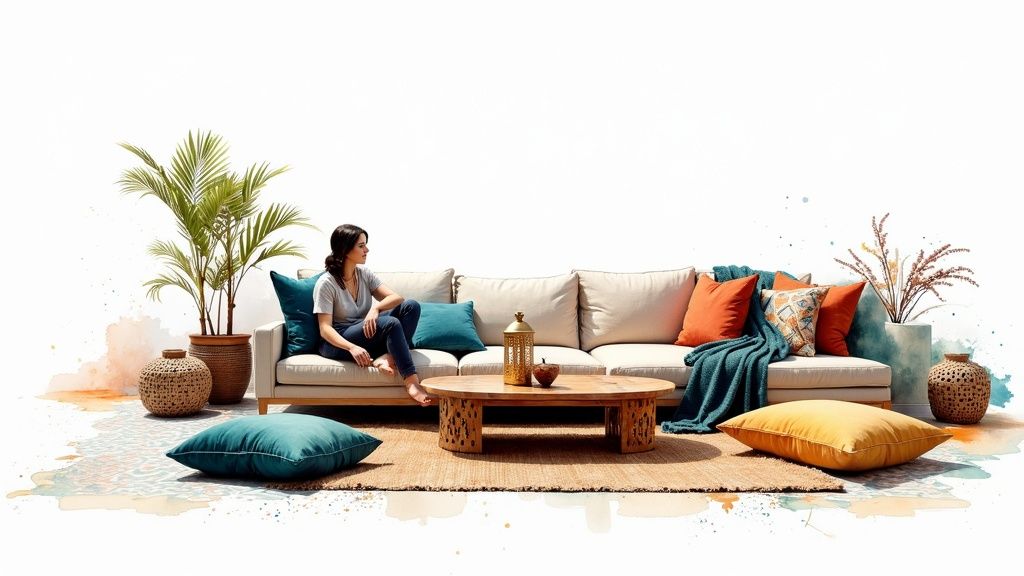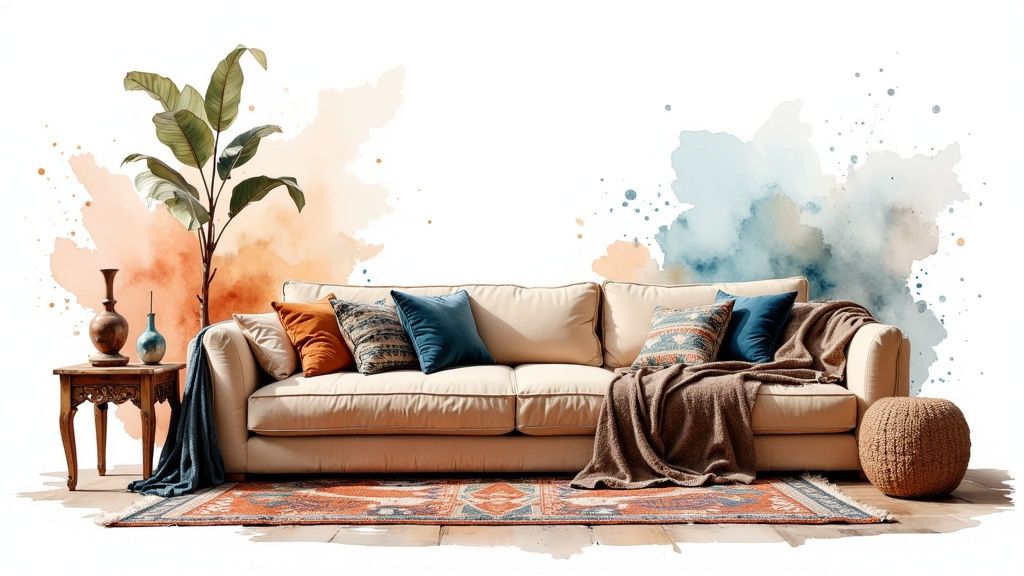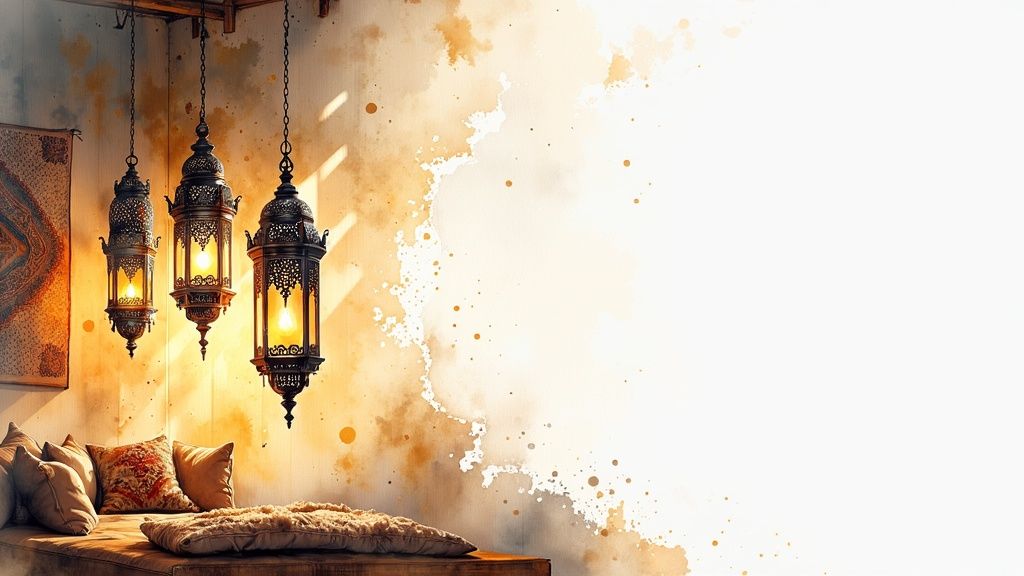Create Your Moroccan Style Living Room

A Moroccan-style living room is so much more than just a decorating trend; it’s an entire vibe. It’s about creating a warm, deeply inviting space that wraps you in comfort, defined by its rich colors, layered textures, and intricate, handcrafted details.
This isn’t a look you can achieve by just scattering a few themed items around. It’s a design philosophy that draws from a deep well of Berber, Arab, and Mediterranean traditions to create a sanctuary built for hospitality and relaxation.
Getting to the Heart of Moroccan Design
To really nail the authentic Moroccan feel, you have to understand the “why” behind the aesthetic. It’s a style born from centuries of cultural exchange, resulting in a look that feels both wonderfully exotic and intimately personal. It’s less about copying a picture from a magazine and more about embracing the spirit of the design.
A few core principles really define this design language:
- A Celebration of Craftsmanship: Handmade pieces are the soul of the room. We’re talking about hand-painted zellige tiles, intricately carved wooden furniture, and hand-woven textiles that tell a story.
- Layered Comfort: The goal is always a cozy, welcoming atmosphere. This comes to life through plush rugs you can sink your feet into, an abundance of floor cushions for casual seating, and soft, ambient lighting.
- Architectural Details: Look for iconic features like arched doorways, built-in wall niches for displaying treasures, and the beautiful, smooth decorative plasterwork known as tadelakt.
The global appeal of this look is massive. An estimated 2 million spaces worldwide now feature key Moroccan design elements. The interest just keeps climbing, too, with around 5 million consumers actively searching for Moroccan-inspired decor to bring those traditional Berber, Arab, and Mediterranean vibes into their own homes.
Moroccan design is a full sensory experience. It’s the feeling of a plush wool rug under your feet, the mesmerizing dance of light filtering through a metal lantern, and the vibrant energy from a jewel-toned color palette. It’s a style that genuinely invites you to slow down, get comfortable, and just be.
For those wanting to capture this exotic aesthetic without breaking the bank, exploring some creative budget home decorating ideas can make all the difference. You don’t need a massive investment—the key is to focus on rich textiles, a bold color palette, and a few impactful accessories to create your own unique story.
Building Your Moroccan Color And Texture Palette
Finding the right mix of hues and surfaces is where the magic of a Moroccan living room truly begins. Your choice of colors sets the tone—whether you crave vibrant energy or a calm, sunlit retreat. Let’s explore how to pick a direction and layer in texture for an authentic finish.
Choosing A Color Direction
When you picture a classic Moroccan salon, two distinct palettes come to mind. One is daring and jewel-like; the other, earthy and understated. Both can feel entirely different under the same ceiling.
Jewel-Tone Energy
Imagine the spice markets of Marrakech: walls awash in sapphire blue, curtains draped in ruby red, cushions in emerald green, and accents of saffron yellow. These deep, saturated hues thrive when layered—on plastered walls, oversized rugs, and voluminous drapes.
Neutral Desert Calm
Now picture the dunes at dusk. Terracotta walls soften into sand, beige, and warm white. Here, subtle shifts in tone do the work. Texture becomes your hero, from woven baskets to weathered wood, ensuring the room never drifts into bland territory.
Moroccan Color Palette Options
Below is a side-by-side look at how these two schemes shape mood and style in your living room space.
| Element | Vibrant Jewel-Tone Palette | Neutral Desert Palette |
|---|---|---|
| Base Hues | Sapphire Blue, Ruby Red, Emerald Green | Terracotta, Sand, Warm White |
| Accent Highlights | Saffron Yellow, Metallic Brass, Patterned Tile | Soft Leather, Woven Grass Baskets, Matte Ceramic |
| Textural Focus | Plush Velvet, Silk Drapery, Glossy Tile | Rough-Hewn Wood, Handwoven Rugs, Tadelakt-style Plaster |
| Lighting Ambiance | Layered Lanterns with Colored Glass | Soft, Diffused Lampshades and Recessed Spotlights |
Whether you lean into drama or serenity, this table will help you visualize the overall feel and pick a starting point for fabrics, paint, and décor.
Embrace Tactile Surfaces
Authenticity in Moroccan design comes alive through touch. Here’s how to bring that sensory richness into your walls and floors:
- Tadelakt Wall Finish – A water-resistant lime plaster, polished by hand until it gleams. Its subtle ripples catch light beautifully.
- Plush Beni Ourain Rugs – Thick wool underfoot, often featuring minimalist geometric patterns on a creamy backdrop.
- Silk and Velvet Textiles – Use these in throws, pillows, or drapes to introduce soft luster.
- Polished Metal Accents – Brass or silver trays, lanterns, and mirror frames add a cool, reflective counterpoint.

This visual snapshot shows how color, texture, and lighting dance together—from ornate tile patterns to the gentle glow of handcrafted lanterns.
Weaving Your Palette Together
The global appetite for North African–inspired décor is growing. In fact, analysts estimate the Moroccan home décor market could reach US$123.16 million by 2025. That speaks to our craving for spaces that feel both worldly and welcoming.
Pro Tip: If you can’t decide between palettes, start with a neutral backdrop and introduce jewel tones through smaller pieces—a plush pouf, a bold throw pillow, or a set of intricate candle holders. It creates a layered, lived-in vibe without overwhelming the room.
For deeper advice on balancing hues in any space, explore how to choose color schemes in our comprehensive guide.
Choosing Authentic Moroccan Furniture and Seating

The real soul of a Moroccan-style living room isn’t in a stuffy, matched three-piece suite. It’s all about low-profile, communal seating that invites people to truly relax and connect. Forget formality. The entire point is to create intimate, cozy nooks that put comfort and togetherness first.
This spirit of hospitality is physically built on layers of flexible seating. Floor cushions and poufs aren’t just afterthoughts; they’re essential. In fact, one of the most defining features of a classic Moroccan interior is the abundance of low-slung seating and floor pillows—a tradition that’s making a big comeback in modern design for its blend of comfort and cultural character.
The Essential Furniture Pieces
While comfort is king, it’s the craftsmanship that adds the visual poetry. A few key pieces really anchor the authentic Moroccan look, each one a perfect marriage of function and ornate artistry.
- Intricately Carved Wood Tables: Keep an eye out for low-to-the-ground tea tables. They’re often hexagonal or octagonal and feature incredibly detailed carvings or delicate brass inlay. These act as the natural gathering spot for mint tea and long conversations.
- Ornate Inlay Chests: These chests, known as Moucharabieh, are works of art that also happen to be great for storage. They are often decorated with mother-of-pearl or bone, arranged in mesmerizing geometric patterns.
- The Iconic Leather Pouf: Honestly, is a Moroccan room even complete without one? These are the ultimate multi-taskers—use them as a footstool, an extra seat, or even a small side table. You can’t go wrong with classic tan leather, but a bold, dyed color like deep red or blue can really pop.
- Low Wooden Benches: A simple, beautifully carved bench pushed against a wall becomes the perfect seating solution when layered with plush cushions and throws. It offers plenty of space without the heavy footprint of a traditional sofa.
The real secret is arranging furniture to encourage interaction. Forget straight lines and think more in terms of circles and clusters. Your layout should feel natural, making it easy for people to face each other, share a space, and just talk.
Sourcing and Styling Your Seating
Pulling this look together doesn’t mean you need to book a flight to a Marrakech souk (though that would be amazing!). You can find fantastic, authentic pieces at specialty import stores or discover inspired alternatives that will blend right in.
I often hear people worry that a bunch of floor cushions will make their living room look like a college dorm. The trick is to be intentional with your layering and to focus on quality. Invest in well-made, oversized floor cushions in rich textures like velvet, embroidered linen, or woven wool. Stack a couple together to create a more substantial seat, or cluster them around a large brass tray on the floor to make a stunning focal point. For more ideas on layouts, check out our guide on how to arrange living room furniture for any design style.
Don’t be afraid to mix things up. Pairing Moroccan elements with more contemporary furniture can create a really unique, curated vibe. Imagine a sleek, modern sofa surrounded by a few leather poufs. Or place an ornate, carved side table next to a simple, clean-lined armchair. It’s this blend of old and new, intricate and simple, that makes a space feel truly personal and well-designed.
Illuminating Your Space with Moroccan Lighting
More than anything else, lighting is where the soul of a Moroccan-style living room truly comes alive. It’s the most powerful tool you have for creating that signature moody, enchanting atmosphere. We’re not talking about harsh, functional overhead lights here. Moroccan lighting is all about casting intricate shadows and bathing the room in a warm, inviting glow.
The real goal is to paint with light. Think of your fixtures as sculptural art pieces that just happen to illuminate. Picture the light filtering through the narrow alleyways of a medina—dappled, soft, and full of mystery. Bringing that feeling into your living room is what turns it into a magical retreat after the sun goes down.
Mastering the Art of Layered Light
A single light in the middle of the ceiling is the fastest way to kill a Moroccan vibe. Instead, the whole look hinges on layering different types of light to build depth and carve out intimate little zones within the room. This approach makes every corner feel intentional and cozy.
Your lighting plan should feel like a symphony, with multiple sources all working together. I always suggest starting with one dramatic focal point and then building out from there with smaller, complementary fixtures. It’s this layering that gives the space its rich, dynamic character.
Here’s how I typically approach building those layers:
- The Statement Piece: A large, perforated metal lantern is perfect for this. Hang it low over a coffee table or right in the center of the room. It’s not just a light; it’s a dramatic centerpiece that throws mesmerizing patterns across the walls and ceiling.
- Ambient Glow: This is where colorful glass table lamps or floor lamps come in. Placed in a few key spots, they provide a warm, diffused light that softens the room’s edges while adding those beautiful, jewel-toned pops of color.
- Cozy Nooks: Don’t forget smaller lanterns or wall sconces for reading corners or seating areas. These create self-contained pockets of light that are perfect for getting lost in a book or having a quiet conversation.
The real magic of Moroccan lighting isn’t about the fixtures themselves—it’s about the shadows they create. That constant interplay between light and dark is what delivers the captivating, almost theatrical, atmosphere.
Choosing the Right Fixtures and Bulbs
The fixtures you choose will completely define the quality of light and the patterns in your space. Each style has a specific job to do in creating that layered, atmospheric look.
Look for classic brass or bronze lanterns with those intricate, hand-punched patterns. They are the workhorses of Moroccan design, responsible for the iconic dancing shadows everyone loves. To complement them, find table lamps with stained glass panels in deep blues, reds, or ambers to wash the corners of your room in rich, warm color.
Don’t overlook the bulbs—they’re just as important as the fixtures. Always opt for warm white or amber-tinted bulbs with a low Kelvin rating, somewhere between 2200K and 2700K. A harsh, cool-toned LED bulb will instantly shatter the cozy, fire-lit illusion. And I can’t recommend dimmer switches enough; they are essential for dialing the mood up or down as the evening goes on.
Layering in Authentic Moroccan Decor and Textiles

The accessories are where a Moroccan-style living room truly comes alive and tells its story. This is the part where you get to infuse your own personality into the space, detail by detail.
Focusing on craftsmanship is the key to achieving that authentic, lived-in feel. Handcrafted items carry a sense of history and tradition, anchoring the room with soul. Even a single, beautifully made plate or tray can become a wonderful conversation starter.
Think about incorporating pieces like:
- Hand-painted ceramics to bring vibrant patterns to an empty wall.
- Ornate mirrors to bounce light around and add a touch of architectural illusion.
- Intricate silver tea trays that signal a ritual of hospitality.
- Antique-looking brass candlesticks for a warm, flickering glow.
I once stumbled upon a set of Fes pottery with stunning cobalt blue motifs, and it completely redefined the gallery wall I was planning. That one unexpected find transformed the room from feeling staged to feeling genuinely soulful.
Selecting Hand-Painted Ceramics
When you’re looking for hand-painted ceramics, keep an eye out for slight variations in texture and minor imperfections. These little nuances are the tell-tale signs of true artisan work, distinguishing them from mass-produced items.
Bowls from local souks or specialty importers often double as sculptural art. Displayed on a set of simple floating shelves, they can easily become a compelling focal point.
A few tips for picking the right ceramics:
- Choose pieces with colors that complement your existing wall palette.
- Create visual interest by mixing large wall plates with smaller decorative bowls.
- Balance intricate geometric patterns with simpler, solid-colored shapes to avoid overwhelming the eye.
This curated approach makes your collection feel intentional and cohesive, allowing each unique piece to stand out and be appreciated.
Mixing Embroidered Pillows and Blankets
Textiles are essential for adding warmth, texture, and a sense of comfort. A Handira wedding blanket, with its sequins and fringe, draped casually over a sofa instantly evokes a sense of heritage and celebration.
Don’t be afraid to mix and match. Pair richly embroidered pillows from Marrakech with a few simple silk or velvet cushions for a beautiful contrast in texture. I once layered a vintage wedding blanket over a very sleek, modern sofa, and the combination felt perfectly balanced—like an unexpected but harmonious duet.
Here’s a simple way to style your sofa:
- Start with your neutral sofa as a base.
- Place two bold, patterned pillows at the corners.
- Add one highly textured pillow right in the center.
- Finally, drape a beautiful blanket over one arm for a relaxed, inviting flair.
Authentic layering is less about abundance and more about curation.
The goal is to let each textile breathe while still creating a cozy, inviting cluster.
Styling Mirrors and Trays
Mirrors and trays do more than just sit there; they reflect both light and your lifestyle. A well-placed mirror can amplify the candlelight dancing from your lanterns, while a traditional silver tray makes serving a simple cup of mint tea feel like a special ceremony.
Here’s how different metallic elements can work in your space:
| Item | Effect | Best Placement |
|---|---|---|
| Ornate Mirror | Expands the room and reflects details | Above a console table or mantel |
| Silver Tray | Adds a cool, metallic contrast | On a coffee table or ottoman |
| Brass Bowl | Introduces a warm, textural element | Tucked into a shelf cluster |
Grouping these items together, maybe on a high shelf or a low side table, builds a layered vignette. Playing with different heights and materials guides the eye and creates little pockets of interest throughout the room.
My final tip? Resist the urge to fill every single nook and cranny. A little negative space is your friend—it gives each object room to breathe and accentuates its unique story.
For more foundational guidance on styling and layering, check out our guide on interior design tips for beginners.
Remember, decorating is an evolving practice. Tweak your arrangements with the seasons or add new treasures from your travels. Let your Moroccan living room be a living narrative that grows and changes with you.
Your Top Moroccan Design Questions, Answered
When you start dreaming up a Moroccan-style living room, a lot of practical questions pop up. It’s one thing to fall in love with a photo on Pinterest, but it’s another thing entirely to bring that rich, layered look into your own home, on your own budget. Let’s dig into some of the most common hurdles you might face.
I’ve been there myself, so my goal is to give you straightforward, real-world advice. This will give you the confidence to get started, whether you’re decorating a tiny apartment or trying to weave those beautiful exotic pieces in with your modern furniture.
How Can I Create a Moroccan Look on a Tight Budget?
You absolutely do not need a massive budget to capture that Moroccan magic. The secret is to zero in on high-impact, low-cost elements that instantly set the right mood. A great place to start is with a single accent wall painted in a warm, earthy terracotta or a deep sapphire blue.
Then, hit the flea markets and thrift stores—they’re goldmines for hidden gems like brass trays, intricately carved wooden boxes, or colorful textiles. DIY is also your best friend here. Think about stenciling a classic Moroccan pattern onto an old side table or sewing your own floor cushion covers from fabric remnants. And instead of splurging on an authentic Beni Ourain rug, find an affordable jute rug with a simple diamond pattern that gives you a similar vibe.
Key Takeaway: My best advice is to prioritize one or two authentic statement pieces—maybe a unique lantern or a handcrafted pouf—and let the rest of the room build around them over time. This makes the whole process feel more accessible and lets your space evolve organically.
Can I Mix Moroccan Decor with My Modern Furniture?
Yes, you can, and you should! Honestly, this kind of fusion often creates the most interesting and personal spaces. The trick to pulling it off is finding a common thread that connects the different styles.
Let’s say you have a sleek, minimalist sofa. You can soften its clean lines with a pile of plush, colorful Moroccan pillows and drape a hand-woven throw over one arm. Or, you could place an ornate, hand-hammered Moroccan tray table on top of a simple, modern rug. It’s all about creating a beautiful, intentional balance between minimalist forms and intricate details. Sticking to a cohesive color palette is the glue that will make the different styles feel connected instead of chaotic.
Will Moroccan Style Make My Small Living Room Feel Cluttered?
Not if you’re smart about it. For smaller spaces, I always recommend leaning into a lighter, more neutral Moroccan palette. Think whites, creams, and sandy beiges—these shades will make the room feel much more open and airy.
Here are a few techniques that work wonders in tight quarters:
- Embrace Mirrors: An arched mirror is a classic Moroccan architectural touch, but it also does double duty by reflecting light and creating an illusion of depth. It’s a game-changer.
- Choose Smart Furniture: Look for pieces that can multitask, like a storage pouf that works as a seat or a small table.
- Go Vertical: Instead of crowding the floor, draw the eye upward. Hang lanterns from the ceiling and display hand-painted ceramics on a set of floating shelves.
A few well-chosen pieces are all you need to evoke the style without overwhelming the room.
What Are the Most Essential Elements to Get the Look Right?
If you had to boil it all down, I’d say focus on three things: rich textiles, atmospheric lighting, and low-slung seating. A textured rug and a mix of patterned pillows are non-negotiable; they create that layered comfort that is so central to the look.
Next, you need at least one perforated metal lantern. It’s what will cast those iconic, mesmerizing light patterns across your walls at night. Finally, add a classic leather pouf or a small cluster of floor cushions. These three elements are truly the heart of the style, introducing that relaxed, low-to-the-ground hospitality Morocco is known for.
Ready to visualize your perfect Moroccan-inspired oasis? With RoomGenius, you can upload a photo of your living room and see stunning redesigns in seconds. Stop guessing and start designing. Try RoomGenius today!